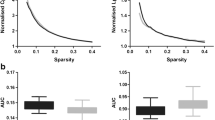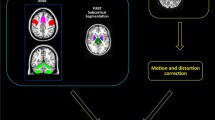Abstract
Purpose
Primary writing tremor (PWT) is a rare task-specific tremor, which occurs only while writing or while adopting the hand in the writing position. The basic pathophysiology of PWT has not been fully understood. The objective of this study is to explore the alterations in the resting state functional brain connectivity, if any, in patients with PWT using graph theory-based analysis.
Methods
This prospective case-control study included 10 patients with PWT and 10 age and gender matched healthy controls. All subjects underwent MRI in a 3-Tesla scanner. Several parameters of small-world functional connectivity were compared between patients and healthy controls by using graph theory-based analysis.
Results
There were no significant differences in age, handedness (all right handed), gender distribution (all were males), and MMSE scores between the patients and controls. The mean age at presentation of tremor in the patient group was 51.7 ± 8.6 years, and the mean duration of tremor was 3.5 ± 1.9 years. Graph theory-based analysis revealed that patients with PWT had significantly lower clustering coefficient and higher path length compared to healthy controls suggesting alterations in small-world architecture of the brain. The clustering coefficients were lower in PWT patients in left and right medial cerebellum, right dorsolateral prefrontal cortex (DLPFC), and left posterior parietal cortex (PPC).
Conclusion
Patients with PWT have significantly altered small-world brain connectivity in bilateral medial cerebellum, right DLPFC, and left PPC. Further studies with larger sample size are required to confirm our results.



Similar content being viewed by others
References
Bain PG (2011) Task-specific tremor. Handb Clin Neurol. doi:10.1016/B978-0-444-52014-2.00050-1
Qayyum Rana A, Vaid HM (2012) A review of primary writing tremor. Int J Neurosci 122:114–118. doi:10.3109/00207454.2011.635827
Rothwell JC, Traub MM, Marsden CD (1979) Primary writing tremor. J Neurol Neurosurg Psychiatry 42:1106–1114. doi:10.1136/jnnp.45.11.988
Kachi T, Rothwell JC, Cowan JM, Marsden CD (1985) Writing tremor: its relationship to benign essential tremor. J Neurol Neurosurg Psychiatry 48:545–550. doi:10.1136/jnnp.48.6.545
Pita Lobo P, Quattrocchi G, Jutras M-F et al (2013) Primary writing tremor and writer’s cramp: two faces of a same coin? Mov Disord 28:1306–1307. doi:10.1002/mds.25340
Modugno N, Nakamura Y, Bestman S et al (2002) Neurophysiological investigations in patients with primary writing tremor. Mov Disord 17:1336–1340. doi:10.1002/mds.10292
Jhunjhunwala K, George L, Kotikalapudi R et al (2016) A preliminary study of the neuroanatomical correlates of primary writing tremor: role of cerebellum. Neuroradiology 154:918–925. doi:10.1007/s00234-016-1700-3
Berg D, Preibisch C, Hofmann E, Naumann M (2000) Cerebral activation pattern in primary writing tremor. J Neurol Neurosurg Psychiatry 69:780–786. doi:10.1136/jnnp.69.6.780
Sahni H, Jayakumar PN, Pal PK (2010) Functional magnetic resonance imaging in primary writing tremor and writer’s cramp: a pilot study. Ann Indian Acad Neurol 13:192–197. doi:10.4103/0972-2327.70884
Wang J, Zuo X, He Y (2010) Graph-based network analysis of resting-state functional MRI. Front Syst Neurosci 4:16. doi:10.3389/fnsys.2010.00016
Achard S, Salvador R, Whitcher B et al (2006) A resilient, low-frequency, small-world human brain functional network with highly connected association cortical hubs. J Neurosci 26:63–72. doi:10.1523/JNEUROSCI.3874-05.2006
Stacy MA, Elble RJ, Ondo WG et al (2007) Assessment of interrater and intrarater reliability of the Fahn-Tolosa-Marin tremor rating scale in essential tremor. Mov Disord 22:833–838. doi:10.1002/mds.21412
Oldfield RC (1971) The assessment and analysis of handedness: the Edinburgh inventory. Neuropsychologia 9:97–113. doi:10.1016/0028-3932(71)90067-4
Dosenbach NUF, Nardos B, Cohen AL (2010) Prediction of individual brain maturity using fMRI. Science 329(80):1358–1361. doi:10.1111/j.1365-2699.2011.02621.x
Fornito A, Zalesky A, Bullmore ET (2010) Network scaling effects in graph analytic studies of human resting-state fMRI data. Front Syst Neurosci 4:22. doi:10.3389/fnsys.2010.00022
Rubinov M, Sporns O (2010) Complex network measures of brain connectivity: uses and interpretations. NeuroImage 52:1059–1069. doi:10.1016/j.neuroimage.2009.10.003
He Y, Dagher A, Chen Z et al (2009) Impaired small-world efficiency in structural cortical networks in multiple sclerosis associated with white matter lesion load. Brain 132:3366–3379. doi:10.1093/brain/awp089
Feder KP, Majnemer A (2007) Handwriting development, competency, and intervention. Dev Med Child Neurol 49:312–317. doi:10.1111/j.1469-8749.2007.00312.x
Roux FE, Draper L, Köpke B, Démonet JF (2010) Who actually read Exner? Returning to the source of the frontal “ writing centre” hypothesis. Cortex 46:1204–1210. doi:10.1016/j.cortex.2010.03.001
Horovitz SG, Gallea C, Najee-ullah MA, Hallett M (2013) Functional anatomy of writing with the dominant hand. PLoS One. doi:10.1371/journal.pone.0067931
Katanoda K, Yoshikawa K, Sugishita M (2001) A functional MRI study on the neural substrates for writing. Hum Brain Mapp 13:34–42. doi:10.1002/hbm.1023
Coffman KA, Dum RP, Strick PL (2011) Cerebellar vermis is a target of projections from the motor areas in the cerebral cortex. Proc Natl Acad Sci 108:16068–16073. doi:10.1073/pnas.1107904108
Patel N, Jankovic J, Hallett M (2014) Sensory aspects of movement disorders. Lancet Neurol 13:100–112. doi:10.1016/S1474-4422(13)70213-8
Wills AJ, Jenkins IH, Thompson PD et al (1995) A positron emission tomography study of cerebral activation associated with essential and writing tremor. Arch Neurol 52:299–305
Kim JS, Lee MC (1994) Writing tremor after discrete cortical infarction. Stroke 25:2280–2282. doi:10.1002/hbm.21250
Milanov I, Georgiev D (1995) Writer’s cramp and tremor due to brain tumor. Can J Neurol Sci 22:59–61. doi:10.1002/mds.870020205
Creem-Regehr SH (2009) Sensory-motor and cognitive functions of the human posterior parietal cortex involved in manual actions. Neurobiol Learn Mem 91:166–171. doi:10.1016/j.nlm.2008.10.004
Sugishita M, Takayama Y, Shiono T et al (1996) Functional magnetic resonance imaging (fMRI) during mental writing with phonograms. Neuroreport 7:1917–1921
Miller EK, Cohen JD (2001) An integrative theory of prefrontal cortex function. Annu Rev Neurosci 24:167–170. doi:10.1146/annurev.neuro.24.1.167
Jahanshahi M, Jenkins IH, Brown RG et al (1995) Self-initiated versus externally triggered movements. I. An investigation using measurement of regional cerebral blood flow with PET and movement-related potentials in normal and Parkinson’s disease subjects. Brain 118(Pt 4):913–933. doi:10.1016/j.neulet.2004.08.078
Samuel M, Williams SC, Leigh PN et al (1998) Exploring the temporal nature of hemodynamic responses of cortical motor areas using functional MRI. Neurology 51:1567–1575. doi:10.1068/p5610
Kamble N, Netravathi M, Pal PK (2014) Therapeutic applications of repetitive transcranial magnetic stimulation (rTMS) in movement disorders: a review. Parkinsonism Relat Disord 20:695–707. doi:10.1016/j.parkreldis.2014.03.018
Gironell A, Kulisevsky J, Lorenzo J et al (2002) Transcranial magnetic stimulation of the cerebellum in essential tremor: a controlled study. Arch Neurol 59:413–417
Popa T, Russo M, Vidailhet M et al (2013) Cerebellar rTMS stimulation may induce prolonged clinical benefits in essential tremor, and subjacent changes in functional connectivity: an open label trial. Brain Stimul 6:175–179. doi:10.1016/j.brs.2012.04.009
Author information
Authors and Affiliations
Corresponding author
Ethics declarations
Funding
This study was funded by a grant from Department of Biotechnology, India (BT/PR4986/MED/30/753/2012).
Conflict of interest
The authors declare that they have no conflict of interest.
Ethical approval
All procedures performed in studies involving human participants were in accordance with the ethical standards of the National Institute of Mental Health and Neurosciences (NIMHANS) Ethics Committee, Bangalore, India, and with the 1964 Helsinki declaration and its later amendments or comparable ethical standards.
Informed consent
Informed consent was obtained from all individual participants included in the study.
Rights and permissions
About this article
Cite this article
Lenka, A., Jhunjhunwala, K.R., Panda, R. et al. Altered brain network measures in patients with primary writing tremor. Neuroradiology 59, 1021–1029 (2017). https://doi.org/10.1007/s00234-017-1895-y
Received:
Accepted:
Published:
Issue Date:
DOI: https://doi.org/10.1007/s00234-017-1895-y




